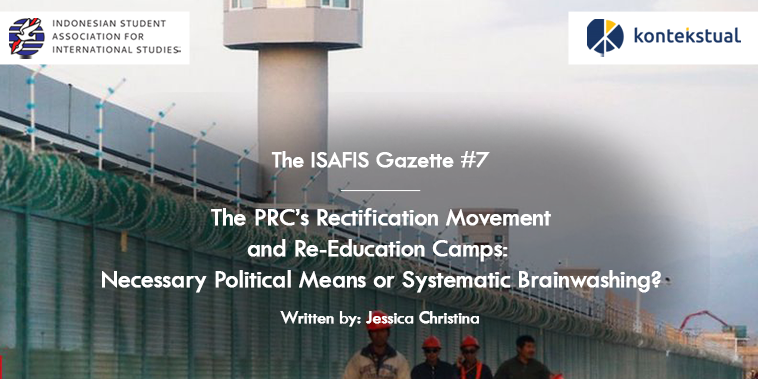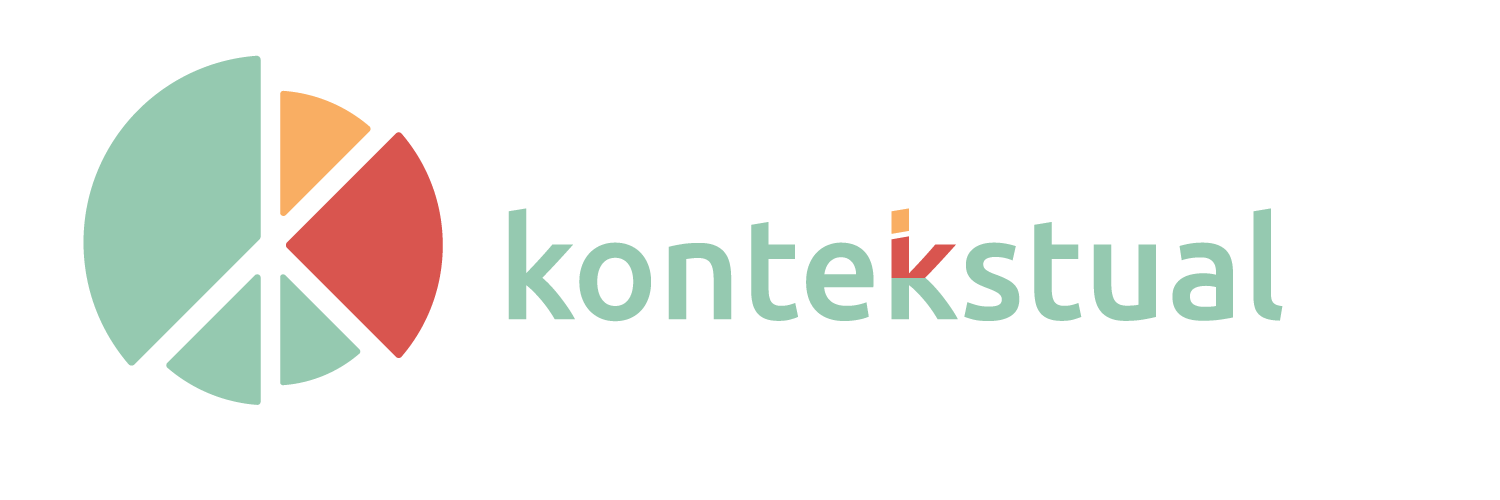The PRC’s Rectification Movement and Re-education Camps: Necessary Political Means or Systematic Brainwashing?

Illustration from ISAFIS
This article is originally published on ISAFIS’ Medium. Click here to be redirected.
For endless reasons, the international public cannot seem to avert its eyes from the People’s Republic of China (PRC). Among many causes, The PRC’s rapid economic growth and ambitious global development strategies signified, and raised, the debate on its rise to become a global superpower rivaling the United States. However, in the PRC’s case, fame came with condemnation. With a keener public spotlight, the PRC could not withhold information of their less commendable policies from being known by external parties. The Xinjiang re-education camps and the PRC government’s treatment toward Uyghur Muslims detained in said camps are among those condemned most by other nations. However, the fact is, similar camps and methods had existed far back since the 1940s. This essay probes deeper back in the PRC’s early history under the hands of Mao Zedong to reveal a long-implemented campaign reenacted in President Xi Jinping’s era and its debates.
In 2018, the existence of ‘political re-education camps’ for Uyghur Muslims in the Xinjiang Uyghur Autonomous Region (XUAR), a northwestern province of the PRC, was revealed in various reports. Officially named the Xinjiang Vocational Education and Training Centers, these camps are used by the PRC government to “cleanse” the Uyghur Muslims from their religious affiliation and ethnic identity—subsequently establishing a new identity under communism and a secular, patriotic political allegiance (Raza, 2019, p. 492). The government claimed it was necessary to ensure the region free of extremist and separatist threats, emphasising its educational purpose. Yet, testimonies by former detainees exemplified how non-educational these re-education camps could be.
Under strict supervision, detainees are obligated to renounce Islam, show devotion towards the Chinese Communist Party (CCP), learn Mandarin, and sing praises to communism (Maizland, 2021). They had to criticise themselves and their fellow Uyghur Muslims for how wrong they were before being ‘corrected’ by the camps. “We would call that brainwashing,” John Sudworth, the BBC’s China Correspondent, remarked at a tour to show selected journalists how these camps educate their ‘students’ inside (BBC News, 2019). Even so, it did not stop there. Some reports highlighted several human rights violations inside these thick walls: torture, sleep deprivation, prison-like conditions, sexual abuses, including rape, and psychological damage that led to suicide (Maizland, 2021).
However, the Chinese are, unfortunately, no stranger to these methods of extreme indoctrination. The Xinjiang Vocational Education and Training Centers were not the first instances where they were detained and ‘corrected’—as the PRC government often dubbed— the minds of people who are deemed as defiant by the government. In fact, it was implemented by the founding father of the PRC, Mao Zedong, in the Yan’an Rectification Movement from 1942 to 1945.
On February 1, 1942, amid the second Sino-Japanese War, Mao Zedong delivered a speech called “Rectify the Party’s Style of Work” (Zhengdun dang de zuofeng, abbreviated to zhengfeng) (Denton, 2010, p. 51). Mao intended to rectify the style of study, Party relations, and writing at the communist base of Yan’an, a city in the Shaanxi province. The rectification movement was then executed in three stages: (1) study sessions discussing twenty-two set documents, including Mao’s own writings; (2) examination period to measure the work of Party groups by the standards written in the documents, and (3) critical writing sessions where each person summarises their own style of work before submitting it to be examined by the group (MacF, 1957, p. 333).
The purpose of the Yan’an Rectification Movement was to educate the masses and cleanse the CCP ideology from unfavourable elements (Kucha & Llewellyn, 2020). In a more political sense, as Gao Hua interpreted in his controversial book How Did the Red Sun Rise: The Cause and Effect of Zhengfeng in Yan’an, the rectification movement was also used to consolidate Mao’s power using coercion. Either way, the Yan’an Rectification Movement was not solely done in an intellectual nor political approach. Terror tactics and violent outcomes were two characters embedded in the enforcement of such movements, even resulting in an estimated 10,000 deaths (Kucha & Llewellyn, 2020). Many were tortured, imprisoned, executed, and some even committed suicide due to the pressure and treatment they had to endure.
The emphasis on ‘educational purpose’, study sessions, self-criticism, false accusations and/or false trials, along with frequent violence. All of that highlights the similarities between the 1940s Yan’an Rectification Movement and the recent Xinjiang re-education camps. The Yan’an Rectification Movement also became a model—to different extents— for many similar CCP-sponsored rectification campaigns in the future, such as the Anti-Rightist Campaign (1957-1959), the Cultural Revolution (1966-1976), the Three Stresses Campaign (1998-2002), and the Campaign to Maintain the Advanced Nature of Communist Party Members (launched in January 2005).
The more apparent abuses against human rights committed in these rectification movements and re-education camps undoubtedly deserved global condemnation. However, the core essence of rectification itself, the re-education process, may still be a debatable subject of discourse. To understand why Mao Zedong first implemented the rectification movement, it is crucial to understand his view on the Chinese revolutionary movement. Mao believed that the Chinese revolutionary movement led by the CCP must go through two stages: the democratic and the socialist revolutions, both with the ultimate aim to bring about a socialist and communist society (Tung, 1966). Considering Mao Zedong’s ambitious goals to reach a socialist China in a relatively short period, one may argue that his decision to adopt the re-education method was justifiable. To realise a socialist and communist society, Mao believed he had to ‘cleanse’ the people, especially inside the CCP, from ideologies that may harm the communist goals.
From an opposing point of view, the rectification movements and re-education camps may be perceived as systematic brainwashing ensued with violence, thus going against the concept of Freedom of Thought (FoT) written in Article 18 of the Universal Declaration of Human Rights (UDHR). Said article accentuated the universal rights to freedom of thought, conscience, and religion (United Nations, 1948). The earlier rectification movements restricted the Chinese people’s freedom of thought, while the Xinjiang re-education camps did both in terms of thoughts and beliefs. Nevertheless, unlike a treaty, the declaration is not legally binding and has no power to urge the PRC into conformation.
In brief, the Xinjiang re-education camps have been a significant discourse among the international public. Historically, it was modelled after the Yan’an Rectification Movement implemented by Mao Zedong in the 1940s. Its original methods, mainly the re-education process, have undeniably sparked debates. The author proposed two differing perspectives on this matter: first, it could be seen as a political means to realise Mao Zedong’s ultimate goal—a socialist and communist China—and second, it could also be perceived as systematic brainwashing.
References
BBC News. (2019, June 18). Inside China’s ‘THOUGHT transformation’ camps – BBC News.
YouTube. https://youtu.be/WmId2ZP3h0c.
Denton, K. A. (2010). 3. rectification: Party DISCIPLINE, Intellectual REMOLDING, and
the formation of a political community. Words and Their Stories, 27, 51–63. https://doi.org/10.1163/ej.9789004188600.i-342.18
Kucha, G., & Llewellyn, J. (2020, March 18). The rectification Movement. Chinese
Revolution. https://alphahistory.com/chineserevolution/rectification-movement/.
MacF, R. (1957). Mao Tse-Tung and the Chinese Communists’ ‘Rectification’ Movement. The
World Today, 13(8), 330-341. Retrieved July 17, 2021, from http://www.jstor.org/stable/40392988
Maizland, L. (2021, March 1). China’s repression of Uyghurs in Xinjiang. Council on Foreign
Relations. https://www.cfr.org/backgrounder/chinas-repression-uyghurs-xinjiang.
Raza, Z. (2019, October 24). CHINA’S ‘POLITICAL RE-EDUCATION’ CAMPS OF
XINJIANG’S UYGHUR MUSLIMS. Taylor and Francis online. https://doi.org/10.1080/03068374.2019.1672433.
Tung, M. T. (1966). Quotations from Mao Tse Tung – Chapter 3.
http://large.stanford.edu/history/kaist/references/marx/mao/c3/.
United Nations. (1948). Universal declaration of human rights. United Nations.
https://www.un.org/en/about-us/universal-declaration-of-human-rights.
Jessica Christina is an International Relations student at Universitas Indonesia and one of ISAFIS’ Foreign Affairs and Institutional Relations Division Staff. She can be found on Instagram with the username of @jessicachrsna





